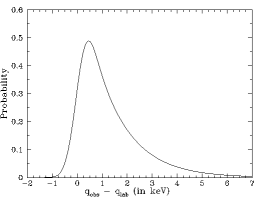 Standard neutrino spectrum from
Standard neutrino spectrum from  B decay
B decay
Numerical values for energy spectra for different solar neutrino sources are available at this url.
 Standard neutrino spectrum from
Standard neutrino spectrum from  B decay
B decay
The Superkamiokande and SNO solar neutrino experiments will measure the shape of the 8B neutrino spectrum above about 5 MeV. An observed distortion of the 8B solar neutrino energy spectrum outside the range given in the present work could be considered as evidence, at an effective significance level of greater than three standard deviations, for physics beyond the standard electroweak model.
 Central Temperature of the Sun Can be Measured via the
7Be Solar neutrino Line
Central Temperature of the Sun Can be Measured via the
7Be Solar neutrino Line

 Shapes
of solar neutrino spectra: unconventional tests of the standard
electroweak model
Shapes
of solar neutrino spectra: unconventional tests of the standard
electroweak model
 Line Versus Continuum Solar Neutrinos
Line Versus Continuum Solar Neutrinos
 Do hep neutrinos affect the solar neutrino energy spectrum ?
Do hep neutrinos affect the solar neutrino energy spectrum ?
 4He + e+ +
4He + e+ +  e,
the `hep'
reaction, is
e,
the `hep'
reaction, is  20 times larger than the best (but uncertain)
theoretical estimates, then
this reaction could significantly influence the electron energy
spectrum produced by solar neutrino interactions and measured
in the SuperKamiokande, SNO, and
ICARUS experiments.
We compare predicted energy spectra for different assumed hep
fluxes and different neutrino oscillation scenarios
with the observed SuperKamiokande spectrum. The spectra with enhanced
hep contributions provide better fits to the SuperKamiokande data.
20 times larger than the best (but uncertain)
theoretical estimates, then
this reaction could significantly influence the electron energy
spectrum produced by solar neutrino interactions and measured
in the SuperKamiokande, SNO, and
ICARUS experiments.
We compare predicted energy spectra for different assumed hep
fluxes and different neutrino oscillation scenarios
with the observed SuperKamiokande spectrum. The spectra with enhanced
hep contributions provide better fits to the SuperKamiokande data.
 Back to John Bahcall (Recent Preprints and Reprints)
Back to John Bahcall (Recent Preprints and Reprints)